Florida Native Non-Venomous Snakes
Both loved and feared, snakes are severely misunderstood creatures. With about 50 species of native snakes in Florida, only six are venomous. Many species of Florida’s snakes do not thrive in residential areas, and the ones that do are usually quite secretive and stay out of sight.
Snakes can be beneficial to the home landscape as predators for rodents like rats and mice, which can carry disease and become pests. Some non-venomous snakes even feed on venomous snakes. They’re also prey for many native animals, playing an important role in the local food web.
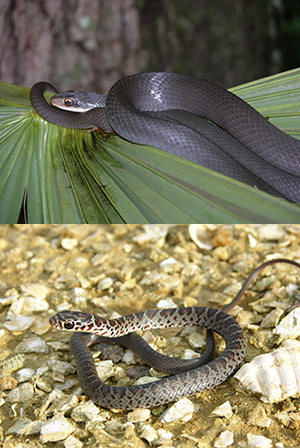
The snakes listed here are native non-venomous snakes frequently encountered in Florida yards, golf courses, parks, retention ponds, and occasionally in homes and garages.
Southern Black Racer
Southern black racers (Coluber constrictor), also called black snakes, are the sleek snakes commonly found sunning themselves on lawns, shrubbery, walkways, and fences. They are quite long, topping off around 4 to 5 feet, with smooth gray/black scales on their backs and bellies, and white on their chins and throats. As the name “racer” implies, they can move quickly, known for being swift and agile. They will flee when approached, but if black racers feel cornered or threatened they’ll shake their tail to make a rattling sound, and may release a foul-smelling “musk.” Juveniles appear different from adults, with gray coloration and a series of reddish-brown blotches down the middle of their backs and small, dark specks on their sides and bellies.
Southern Ring-necked Snake
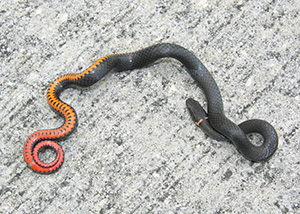
Photo courtesy of Dr. Steve A Johnson.
Southern ring-necked snakes (Diadophis punctatus) are one of the most commonly sighted snakes in Florida’s urban areas. They can be found in mulch or leaf litter, with a tendency to hang out on walkways and sometimes in houses. These small grayish-black snakes don’t usually get past a foot in length and sport a ring of orange or yellow color around the neck. The belly is orange/yellow with a row of dark spots down the center. These snakes are shy and will keep to themselves. When alarmed or threatened, southern ring-necked snakes will coil their tail and may produce a foul scent. They are not aggressive and rarely attempt to bite. These docile snakes pass the time under logs and rocks, feeding on earthworms, slugs, salamanders, lizards, and other small snakes.
Rat Snakes
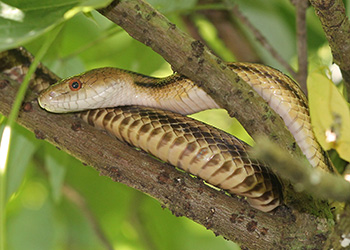
Both yellow rat snakes (Pantherophis alleghaniensis) and red rat snakes (Pantherophis guttatus) are excellent climbers and can be found in residential areas on shrubs or along fences. They can become defensive if cornered and might strike, but are non-venomous. Adult yellow rat snakes are found throughout Florida except the Panhandle and stand out with a distinctive golden coloration and four dark lines running down their backs.
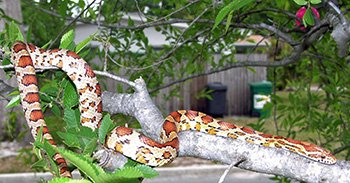
Photo courtesy of Dr. Steve Johnson.
Despite the name, red rat snakes can be tan, gray, or yellow-orange with reddish-orange blotches, usually outlined in black, on their backs and sides. They have an interesting black and white checkerboard pattern on their bellies. Juvenile rat snakes are dull, brownish versions of adults.
Garter Snake
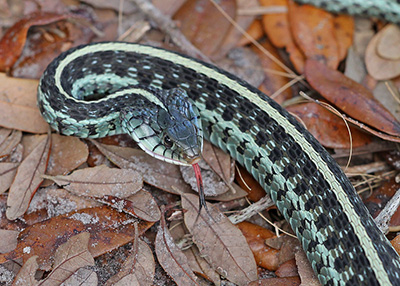
Photo: Mary Keim, some rights reserved.
Garter snakes (Thamnophis sirtalis) run around 2 to 3 feet in length. They are found among landscape plants near houses and along the edges of ditches or ponds, usually feeding on small prey like earthworms, frogs, and salamanders. Garter snakes can be a range of different colors, including gray, blue, yellow, brown, green, and a combination of these colors. They have three light-colored lines running down their backs and a checkerboard pattern of black splotches between the stripes. These snakes are docile, but when threatened may release a foul-smelling musk and flatten their heads and bodies.
Florida Brown Snake
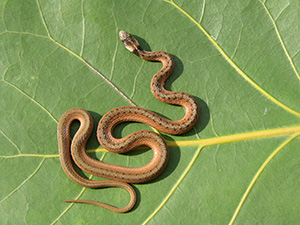
Florida brown snakes (Storeria victa) are small—10 to 12 inches long—and mostly yellowish-brown in color. They are one of two species of brown snakes found in the state and mostly reside on the peninsula of Florida. These snakes often have a light-colored line down the middle of their backs as well as small, dark flecks on their backs and sides. The top of the head is brown-black, with a wide light band and dark band across the neck. These harmless snakes often fall into pools and end up in the skimmer. They feed on worms and slugs and reside under logs, rocks, and debris.
Southern “Banded” Water Snakes
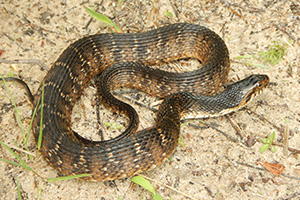
Dr. Steve A Johnson.
Southern water snakes (Nerodia fasciata) are large snakes, reaching up to 3 to 4 feet in length, with rough-looking scales. They usually have dark crossbands on a lighter-colored background. The Florida banded water snake (Nerodia fasciata pictiventris) has similar patterns with additional dark markings on the belly. Both subspecies tend to darken as they age, with older adults sometimes uniformly dark in color. They also have dark stripes from the eye to the corner of the jaw. These water snakes reside near ditches and ponds where they feed on salamanders, frogs, fish, and crayfish.
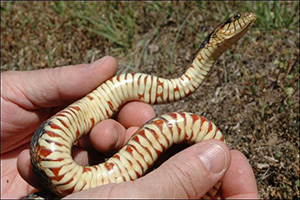
If you come across a dark-colored snake near the water that you cannot identify, keep your distance and leave it be. These water snakes are often misidentified for their similarity in appearance to the venomous cottonmouth water moccasin. Even the non-venomous water snakes might bite if threatened and produce a foul-smelling musk.
By understanding how to identify these snakes and their role in the environment, you can develop an appreciation for their presence in Florida landscapes and feel more at ease out in the yard. Learn more about Florida’s venomous and non-venomous snakes in this publication from Ask IFAS on identifying commonly encountered snakes in Florida residential areas.
